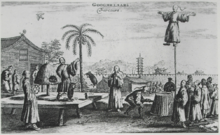Chinese variety art

Chinese Variety Art (Chinese: 雜技藝術) is the name giving to the collection of performances that include a wide range of acrobatic, balancing acts and other spectacles performed by a troupe fashioned in traditional Chinese-style attire. The art originated in China and is still performed today.
Circus vs Variety Art
While the English term "Chinese Circus" has been used to describe Chinese variety arts even in the earliest western historical text, the East views the Chinese term "circus" (馬戲) as a separate western style show altogether. Many exhibitions are similar between the two, and many are different. Elements such as clowns and other large animals are known as western style. Eastern elements include Shaolin monks, Peking opera characters and Monkey King for example.
History

The beginnings of Chinese Performance Arts have been lost to history. It is known that it existed as early as the Qin Dynasty (221-207BC). During the Qin Dynasty, Jiaodi Drama was popular with the common people and it consisted of a variety of acts such as; wrestling, musical performances, dance, martial arts, horsemanship, and juggling.[1] In the Eastern Han Dynasty scholar Zhang Heng was one of the first to describe the acrobatic theme shows in the royal palaces in his writing "Ode to the Western Capital" (西京賦). The event featured shows such as "Old Man Huang of the Eastern Sea" (東海黃公), the "Dancing Fishing Dragon" (魚龍蔓衍) and "Assembly of Immortals" (總會仙倡). A grand acrobatic show was held by Emperor Wu of Han in 108 BC for foreign guests.[2] The performance art routines became more elaborate and during the Tang Dynasty (618-907AD), the performance arts became popular in the Emperor’s court and soon spread to the gentry. Due to its new status, and raise in income, the acts became more refined. Eventually, the performance arts lost favor in the Imperial court and it then moved back to the common people and most performers performed in the street. Towards the end of the Ming Dynasty(1368-1644), the performers came off the street and started performing on stage. During the end of the Qing Dynasty (1644-1911), it regained popularity with the Imperial Court and has remained a popular art form to this day. [3]
Since the founding of the People's Republic of China in 1949, the art forms have gained new respectability. Troupes have been established in the provinces, autonomous regions, and special municipals with theaters specifically dedicated to the variety arts. Some troupes have become world famous, playing to packed houses at home and on foreign tours.
It wasn't until the 1990s, however, when the art form was packaged as a complete theme show. Specifically the 1994 show "Golden Wind of the Southwest" (金色西南風) led the way with major successes in re-promoting the art as a whole.[2]
Performances

Below is a list of performances available in the variety art. Some are more standard, while others are more regional. There is always new innovation taking place.
- Lion dancing on top of rolling globes or balls.
- Tightrope walking
- Contortion acrobatics
- Balancing act while playing Chinese yo-yo
- Shaolin monks resisting projectiles
- Extreme kung fu demonstrations
- unicycle with bowls balancing
- Multi Plate balancing
- Tricks involving smaller animals
- Fire breathing
-
High Wire Acrobats in Huang Shan
-
Contortion Acrobatics
-
Balancing Act on Bicycle
-
Multi Plate Balancing
-
Shaolin Monk
-
Gymnastic Displays
Festivals
See also
- Chinese State Circus
- Chinese art
- Culture of China
- Balancing Acts- a documentary about acrobat Man Fan Tong
References
- ^ "Chinese Performance Arts". Access China Travel.
- ^ a b Qiao. "Qiao." The acrobatic Theme show and its origin in the Hundreds Entertainment. Retrieved on 2007-05-25.
- ^ "Chinese Performance Arts". Access China Travel.






